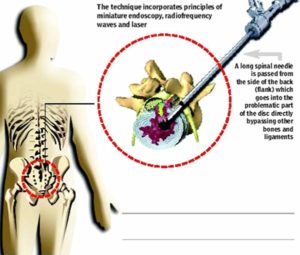The TOI PELD Article

Simpler spine surgery is here
Technique called percutaneous endoscopic lumbar discectomy or stitchless spine surgery helps patients with lower back pain, sciatica, slipped disc
Umesh Isalkar | TNN
Pune: Twenty-five year old Suhas had been suffering from severe pain on his right side in his thigh and leg for more than three months. It hindered his busy schedule as an architect. He had undergone open spine surgery eight years ago to fix a disc prolapse (slipped disc) in the L4-5 vertebrae.
A recent MRI of his spine showed a prolapse at L5-S 1 vertebrae and a recurrent disc herniation (disc bulge) and nerve root compression in the L4-5 vertebrae.
When he heard that the nerve compression could be fixed without a major surgery, he was relieved. Using a relatively newer technique called percutaneous endoscopic lumbar discectomy (PELD) or stitchless spine surgery, the nerve roots at both levels were decompressed. “There was no incision and muscle cutting, it was like a small procedure which relieved me of my severe pain, “said Suhas.
Doctors in Pune are conducting difficult spine surgeries without cutting through muscles and bones.Patients suffering from slipped disc,low back pain due to nerve compression,sciatica are being relived of pain using stitchless spine surgery medically known as PELD. A patient is discharged within 24 hours.
Prashant Kumar was lifting some heavy objects when he felt severe pain in his lower back and buttocks followed by severe leg pain and numbness. An MRI scan clearly showed he was suffering from a slipped disc. Doctors told him,the disc can be removed without any skin incision, Kumar said. He was up and about a day after surgery
“This surgery is a modern technique useful for patients with lower back pain, sciatica and a slipped disc. Not all spine surgeries can be done using PELD. Only certain patients will benefit from the technique,” said neurosurgeon Jaydev Panchawagh of Deenanath Mangeshkar Hospital.
Panchawagh has performed sixty surgeries using PELD in the last six months. “Stitchless spine surgery can help in the early phases of pain when the spine discs have not hardened with time and pain has not become chronic, secondarily affecting the surrounding muscles,” he said.
The technique has matured in the last two to three years and there are many papers establishing its efficacy and advantages. It incorporates principles of miniature endoscopy, radiofrequency waves and laser technique. “It is relatively new in India. There are very few hospitals offering such techniques,” Panchwagh said.
Consultant orthopaedic spine surgeon Sreedharan Namboothiri from Kovai Medical Center and Hospital in Coimbatore said there are seven orthopaedic and neurosurgeons in India who conduct PELD. “It is a relatively new technique, but effective in treating certain spinal problems.” Namboothiri also conducts PELD.
Panchwagh said the surgery can be best performed under simple local anaesthesia. “We leave it to patients to choose the type of anaesthesia one is most comfortable with. There is no need of general anaesthesia in this surgery,” he said.
Patients suffer the pain and see doctors only when the condition is in advanced stages. “When there is intervertebral disc prolapse (slipped disc), a certain percentage of the slipped discs shrivel-up in a few weeks and do not need surgery. However, it is equally clear that a significant number of these discs become hard due to calcification, progressively lodging them in a narrow crevice of the spine, severely compressing the nerves. This causes chronic backache, sciatica and neurogenic claudication, not to mention irreversible nerve damage,” said Panchawagh
The first line of treatment should be non-surgical, but if the symptoms do not regress fast, one should take out the compressive elements,” Panchawagh said.
Low back, thigh and leg pain due to foraminal stenosis (or disc prolapse) can be treated most effectively only with this technique. “This is because the standard posterior open or endoscopic approach is unable to decompress this area easily and effectively as it is covered by a facet joint. So, the patients who used to be either told that ‘nothing much can be done for this condition,’ can now be most definitely and efficiently treated by using PELD,” Panchawagh said.
(Patients names have been changed)
IT IS OFTEN USED TO TREAT
- Herniated discs
- Bulging disks
- Degenerative disc disease
- Pinched nerve or nerve root compression
- Sciatica
- Foraminal compression
After a PELD procedure, the patient is usually discharged within 24 hours, does not require prolonged periods of bed rest, and can get back to work sooner
STITCHLESS SPINE SURGERY
- Percutaneous endoscopic lumbar discectomy is the ultimate form of minimal invasive spine surgery. An instrument called endoscope is used
- Surgery is done under local anaesthesia and patient is fully awake during the procedure. In fact, for successful surgery patients active participation is necessary
- Patient is made to lie prone on operation table and exact entry point is mapped on the body using image intensifier X-ray system
- Through this a needle guidewire is passed then a dilator is passed over the guidewire. The working cannula is passed over the diltaor continuously monitoring the image intensifier X-ray system
- The dilator is then taken out and the spinal endoscope is passed through the working cannula
- Under direct visualisation with the help of the spinal endoscope the disc fragments which are compressing the nerve are removed with miniature manual instruments, radiofrequency waves and laser
- After confirming that the painful nerve is decompressed (relived of compression) the endoscope and the working cannula are taken out
- The small hole in the skin is closed with the help of dressing tape and the procedure is completed
- The patient is allowed to walk immediately after the surgery and is discharged within 24 hours
